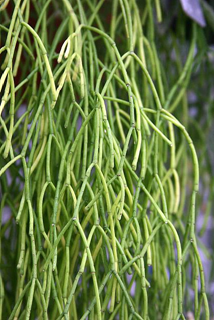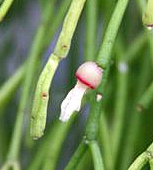Rhipsalis juengeri Barthlott and N.P. Taylor Bradleya 13 (1995)


- Plant - pendulous epiphyte to at least 3 m long, stems terete, scarcely succulent; primary long extension shoots to 200 cm x 3 mm; secondary stem-segments much shorter, green, the flower-bearing segments 1.25-1.75 mm diam.
- Flowers - solitary or rarely paired at or near the apex of the ultimate or lower order stem-segments, campanulate, c. 15 x 12 mm,
- Stamens - yellow at base.
- Fruit - globose-truncate, c. 6 mm
or more in diam., purplish to translucent greenish tinged dark maroon.
Distribution. Brazil (S Sao Paulo): epiphyte in seasonal Atlantic forest, c. 700-800 m altitude.
This new taxon is remarkable for its extremely slender, greatly elongated axes. In its vegetative habit it looks like a giant slender version of R. campos-portoana, but has differently coloured fruit. The plant was originally received from an amateur collector who had obtained it in Brazil without giving precise provenance data and claiming that it was the only Rhipsalis that never flowers! In fact, it must grow to 2 metres in length before beginning to flower and does so freely only when 3 metres of growth have been attained, expanding its flowers in late winter to early spring (in Germany). It is adapted to an epiphvtic habit on rather large trees, but its range and ecology remain poorly understood since it is not presently known from herbarium collections of wild origin, being too difficult to distinguish from its allies once pressed and mounted on the standard-sized herbarium sheet! However, what appears to be this plant was recently observed in habitat, sympatric with R. burchellii, at the Fazenda Intervales forest reserve, Mun., Sete Barras, Sao Paulo. Its purplish, grape-like fruits most nearly resemble those of R. burchellii, while its flowers are closer to those of R. campos-portoana, but we do not suppose it to be of hybrid origin for the reasons already discussed under R. ewaldiana sp. nov.
We name this remarkable new species, in great admiration,
after the writer and scientist Ernst Junger, on the occasion of his
100th birthday in March 1995.
In Nigel Taylor's thesis for the award of Doctor of Philosophy, entitled 'Taxonomy and Phytogeography of the Cactaceae of Eastern Brazil' (October 2000) we find:
'[Re R. juengeri] Only a collection by Zappi (number 259) and one from the Serra Negra have been seen as living plants and suggest the above identity, although neither has been examined in flowering condition. Other collections from Ibitipoca (Mun. Lima Duarte, MG) are referred here with considerable doubt, since it is likely that R. burchellii and the easily confusable R. juengeri can grow together, and there is also the recently named R. ormindoi, from the adjacent parts of Rio de Janeiro, to take into account.'
Notes from Hunt 2006.
Resembling R. clavata, especially in flower and fruit. Not all forms have the extremely long branch segments originally described
Two photos of R. juengeri (copyright KAF, Kew 2006)